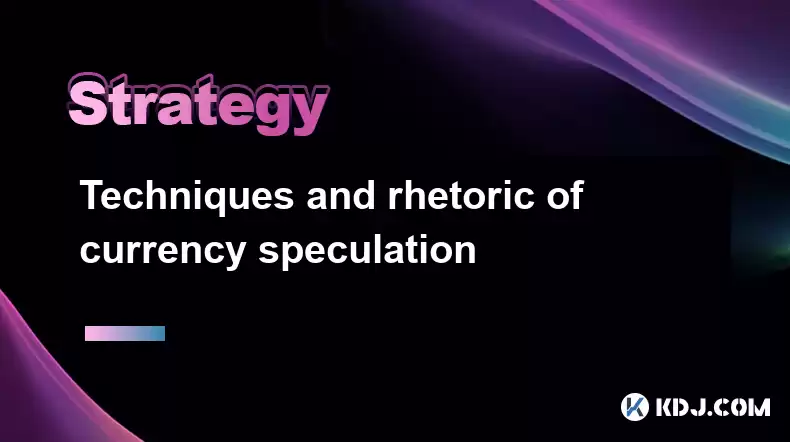-
 bitcoin
bitcoin $110918.433029 USD
-1.69% -
 ethereum
ethereum $3996.872473 USD
-2.43% -
 tether
tether $1.000594 USD
0.00% -
 bnb
bnb $1178.871834 USD
-2.38% -
 xrp
xrp $2.413973 USD
-3.47% -
 solana
solana $194.341461 USD
-4.24% -
 usd-coin
usd-coin $0.999963 USD
-0.03% -
 tron
tron $0.320092 USD
0.92% -
 dogecoin
dogecoin $0.196919 USD
-3.42% -
 cardano
cardano $0.669585 USD
-3.63% -
 hyperliquid
hyperliquid $37.485952 USD
-3.58% -
 ethena-usde
ethena-usde $1.000026 USD
-0.02% -
 chainlink
chainlink $18.018220 USD
-5.13% -
 bitcoin-cash
bitcoin-cash $523.879267 USD
-2.41% -
 stellar
stellar $0.324655 USD
-3.67%
Techniques and rhetoric of currency speculation
Technical analysis, involving chart patterns and indicators, is a widely used tool for currency speculators to identify trading opportunities based on price movements.
Jan 08, 2025 at 09:10 pm

- Understanding Currency Speculation
- Technical Analysis:
- Chart Patterns
- Technical Indicators
- Fundamental Analysis:
- Economic Data
- Company News
- Sentimental Analysis:
- Market Sentiment
- Social Media
- Risk Management Techniques:
- Stop-Loss Orders
- Position Sizing
- Speculative Trading Strategies:
- Swing Trading
- Day Trading
Currency speculation involves buying and selling currencies with the aim of profiting from short-term price fluctuations. Unlike trading stocks or commodities, currency speculators generally do not take ownership of the underlying currency but rather speculate on its future value. This allows for highly leveraged trading and significant potential returns but also carries substantial risks.
Technical AnalysisTechnical analysis is a tool widely used by currency speculators to analyze price charts and identify potential trading opportunities. It assumes that price movements follow predictable patterns and that these patterns can be used to forecast future directions.
- Chart Patterns:
- Technical analysts identify and classify distinctive chart patterns that often precede price reversals or continuations. Some common patterns include head and shoulders, double tops/bottoms, and triangles.
- Technical Indicators:
- Technical indicators are mathematical formulas that transform price data into visual representations, providing additional insights into market conditions. Some popular indicators include moving averages, Bollinger Bands, and the relative strength index (RSI).
Fundamental analysis focuses on the underlying economic and financial factors that influence currency prices. This involves examining macroeconomic data, political events, and company news to gauge the strength of a currency relative to others.
- Economic Data:
- GDP growth, inflation rates, interest rates, and unemployment levels are key economic indicators that can significantly impact currency valuations.
- Company News:
- For currencies tied to specific economies, major announcements from large companies can influence market sentiment and trigger price movements.
Sentimental analysis involves assessing the general sentiment of market participants to identify potential trading opportunities. This involves analyzing social media sentiment, news headlines, and other indicators to gauge investor sentiment towards a particular currency.
- Market Sentiment:
- Positive market sentiment often indicates an expectation of rising prices, while negative sentiment suggests a bearish outlook, influencing currency valuations.
- Social Media:
- Social media platforms like Twitter and Reddit provide a real-time glimpse into market sentiment and can offer valuable insights for speculators.
Effective currency speculation requires comprehensive risk management strategies to mitigate potential losses. These techniques help traders control their trading activities and prevent catastrophic losses.
- Stop-Loss Orders:
- Stop-loss orders automatically close a position when the price reaches a predetermined level, limiting potential losses.
- Position Sizing:
- Position sizing involves adjusting the trade size based on the trader's risk tolerance and account capital, ensuring that potential losses do not exceed a predefined threshold.
Currency speculators employ various trading strategies to capitalize on market fluctuations. These strategies differ in their time horizon, risk tolerance, and profit potential.
- Swing Trading:
- Swing traders hold positions for days or weeks, attempting to capture larger price movements. They identify trading opportunities based on technical analysis and market sentiment.
- Day Trading:
- Day traders buy and sell currencies within a single trading day, capitalizing on intraday price volatility. They rely on short-term technical setups and rapid order execution.
- What are the most important factors to consider when speculating in currencies?
Understanding economic data, technical price patterns, and market sentiment are crucial factors for currency speculators.
- What are the risks associated with currency speculation?
Currency speculation can involve substantial losses due to factors such as market volatility, leverage, and unpredictable geopolitical events.
- How can I improve my currency speculation skills?
Regularly studying market data, practicing technical analysis, and understanding economic factors can significantly enhance speculative trading skills.
- What are the best resources for learning about currency speculation?
Online trading academies, webinars, and specialized books offer valuable resources for novice and experienced currency speculators.
- Is it possible to make consistent profits from currency speculation?
While consistent profits are not guaranteed, disciplined trading, sound risk management, and a thorough understanding of market dynamics can increase the probability of successful speculation.
Disclaimer:info@kdj.com
The information provided is not trading advice. kdj.com does not assume any responsibility for any investments made based on the information provided in this article. Cryptocurrencies are highly volatile and it is highly recommended that you invest with caution after thorough research!
If you believe that the content used on this website infringes your copyright, please contact us immediately (info@kdj.com) and we will delete it promptly.
- Cryptos in Flux: MoonBull's Lunar Stampede, Solana's Struggle, and XRP's ETF Hopes
- 2025-10-17 06:25:11
- Remittix Presale, RTX Token, and DeepSnitch AI: The Next Big Thing in Crypto?
- 2025-10-17 07:25:17
- Bitcoin, Trump & Meme Coins: Newsmax's Bold Move & AlphaPepe's Rise
- 2025-10-17 07:25:17
- SEI Forms Inverse Head & Shoulders: Breakout Imminent?
- 2025-10-17 07:10:01
- Cardone Capital Dives Deeper: Why Grant Cardone is Buying More Bitcoin Now
- 2025-10-17 06:25:11
- Newsmax, Bitcoin, and Trump Coin: A Bold Crypto Play?
- 2025-10-17 07:10:01
Related knowledge

Practical parameter settings for a Bitcoin multi-timeframe moving average system
Sep 18,2025 at 10:54pm
Optimizing Timeframe Combinations for Bitcoin Trading1. Selecting appropriate timeframes is crucial when building a multi-timeframe moving average sys...

How can I filter out false breakouts in Dogecoin high-frequency trading?
Sep 22,2025 at 01:00am
Understanding False Breakouts in Dogecoin Trading1. A false breakout occurs when Dogecoin's price appears to move beyond a defined support or resistan...

Techniques for identifying tops and bottoms in the Bitcoin on-chain NVT model
Sep 20,2025 at 07:54pm
Understanding the NVT Model in Bitcoin Analysis1. The Network Value to Transactions (NVT) ratio is often described as the 'P/E ratio' of the cryptocur...

What does the surge in open interest in Bitcoincoin futures mean?
Sep 20,2025 at 11:18pm
Understanding the Surge in Dogecoin Futures Open Interest1. A surge in open interest within Dogecoin futures indicates a growing number of active cont...

How can I use the Ethereum USDT premium to gauge market sentiment?
Sep 18,2025 at 11:55pm
Understanding the Ethereum USDT Premium1. The Ethereum USDT premium refers to the price difference between USDT (Tether) traded on Ethereum-based plat...

What should I do if Ethereum staking yields decline?
Sep 20,2025 at 06:18am
Understanding the Causes Behind Declining Ethereum Staking Yields1. The Ethereum network transitioned to a proof-of-stake consensus mechanism with the...

Practical parameter settings for a Bitcoin multi-timeframe moving average system
Sep 18,2025 at 10:54pm
Optimizing Timeframe Combinations for Bitcoin Trading1. Selecting appropriate timeframes is crucial when building a multi-timeframe moving average sys...

How can I filter out false breakouts in Dogecoin high-frequency trading?
Sep 22,2025 at 01:00am
Understanding False Breakouts in Dogecoin Trading1. A false breakout occurs when Dogecoin's price appears to move beyond a defined support or resistan...

Techniques for identifying tops and bottoms in the Bitcoin on-chain NVT model
Sep 20,2025 at 07:54pm
Understanding the NVT Model in Bitcoin Analysis1. The Network Value to Transactions (NVT) ratio is often described as the 'P/E ratio' of the cryptocur...

What does the surge in open interest in Bitcoincoin futures mean?
Sep 20,2025 at 11:18pm
Understanding the Surge in Dogecoin Futures Open Interest1. A surge in open interest within Dogecoin futures indicates a growing number of active cont...

How can I use the Ethereum USDT premium to gauge market sentiment?
Sep 18,2025 at 11:55pm
Understanding the Ethereum USDT Premium1. The Ethereum USDT premium refers to the price difference between USDT (Tether) traded on Ethereum-based plat...

What should I do if Ethereum staking yields decline?
Sep 20,2025 at 06:18am
Understanding the Causes Behind Declining Ethereum Staking Yields1. The Ethereum network transitioned to a proof-of-stake consensus mechanism with the...
See all articles










































































